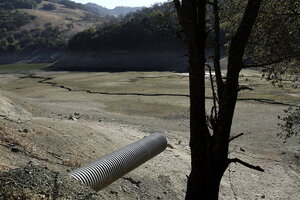California drought: Scientists puzzled by persistence of blocking 'ridge'
Many states have seen an easing of drought conditions, but not California, mired in its worst in more than a century. The culprit, a high pressure ridge parked offshore that is blocking winter storms.

A water pipe that normally carries water is shown above the nearly dry Almaden Reservoir near San Jose, California January 21. Gov. Jerry Brown last week declared a drought emergency, and the dry year of 2013 has left fresh water reservoirs with a fraction of their normal water reserves.
Robert Galbraith/Reuters
Los Angeles
While much of the United States has experienced a weather year with fewer extremes and an easing drought, the record-breaking California drought – the worst since 1895 – is not leaving the region anytime soon, according to climatologists.
The unseasonal balmy but dry weather is the result of an equally unprecedented high pressure ridge lurking offshore and blocking the typical winter storms needed to drop precipitation all along the West Coast.
This ridge has persisted for 13 months and the longer it lingers, the less likely it is to leave, points out climatologist Brian Fuchs, from the National Drought Mitigation Center in Lincoln, Nebraska. This high pressure ridge system is feeding on itself, “creating a sort of perfect environment for perpetuating the dry conditions” it creates, he says.
High-pressure systems are not uncommon, but it is abnormal for them to hang around uninterrupted for so long. “This makes it even harder as winter storms approach for them to break through and change that pattern,” he adds.
This recent dry spell accentuates a continuing background condition of prevailing drought across much of the Southwestern US, notes Christopher Williams, a specialist in US drought conditions and an assistant professor at Clark University’s Graduate School of Geography in Worcester, Mass.
Precipitation is below 20 percent of normal and signs of the drought impact run across the region, including low river flows, low snow packs, low reservoir levels, and out-of-season wildfires.
“Wintertime shortages are particularly worrisome,” adds Mr. Williams via e-mail, “because winter is a key time of year for building up water supplies that carry the West through the rest of the year.” What is worse, he says, “shortfalls extend well beyond the state of California itself, reaching nearly all of the remote regions on which the California water supply network relies, particularly the Colorado River Basin.”
Scientists are uncertain as to why the ridge has stubbornly refused to break down and allow incoming storms to hit land. Climate change may be one of many factors, suggests Mr. Fuchs.
“It’s always difficult to know if a specific disaster or storm is tied to climate change,” he says, but over the course of decades it is possible to see large trends moving in a certain direction. “You can’t really pinpoint one thing, but you can say that over a period of decades there is less snow accumulation and warmer temperatures, and climate change is playing a part in that,” he adds.
On Friday, California Gov. Jerry Brown declared a drought emergency, calling for a 20-percent voluntary conservation effort state-wide.
This is just the beginning, says Doug Parker, director of the California Institute for Water Resources. “We have seen essentially no rain or snowfall this year and short- and long-term forecasts are bleak for California,” says Mr. Parker via e-mail, adding that this means that California will have very low water deliveries to much of its agricultural sector.
This agriculture is an important part of the state’s economy, points out Parker. “This will lead to fallowing of farmland which will reduce output and reduce employment,” he suggests, adding that could drive up the prices of certain commodities. In addition, the dairy and meat sectors will be particularly hard hit, he notes, as those sectors will have to import feed.
The drought throughout the West will impact other states similarly, points out Parker.
The drought will increase pressure on already over-used groundwater supplies, says Parker. “We have seen dropping groundwater levels in many parts of the state. We expect growers to increase use of groundwater, especially for tree and vine crops. This will accelerate the decline in groundwater,” he adds.
Little currently on the horizon offers much hope for change, says California climatologist Mike Anderson, with the Department of Water Resources.
This offshore ridge is very stable, he says, adding, “this is good news if you want nice weather, but if you want precipitation it is not.”

